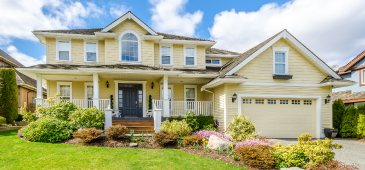For example, say Jack and Jill are house shopping.
They’ve found a nice house in Ardmore for $300,000 and they’re going to purchase it with the help of a HELOC. They’ve saved $90,000 because Lakeland Credit Union (LCU) requires a 30% down payment (or equity in the house) to qualify for a HELOC.
They now have a $210,000 line of credit against their house. The interest rate on their HELOC is variable, meaning it fluctuates with the prime rate. Let’s pretend their interest rate is 4%. That works out to $8,400 annually or $700 monthly. Similar to the minimum charge on a credit card bill, some financial institutions may require they pay only this monthly interest for a set period of time. However, LCU requires members to make at least some payment over and above the interest each month (It is not usually recommended to make only minimum payments on a credit card or HELOC.)
Jack and Jill chose a HELOC because they liked the flexibility. When they first moved into their new house, they wanted to do some renovations and purchase some new furniture. For two months they made just over the minimum payments and used their line of credit, which they accessed through cheques and a regular debit card, to finance the renovations and furniture.
Three months later, Jill receives a $10,000 bonus at work, and they put the money towards their HELOC, thus lowering the amount of interest they owe. For three years they put as much of their income as they can afford towards their HELOC. Then they have a baby and put a bit less towards their HELOC so they can stay home for a while.
HELOCs are sometimes nicknamed the ‘never ending’ mortgage because it can be very tempting to pay just the minimum and use the credit for everyday or exorbitant expenses. If this cycle continues, very little of the principle is ever paid, and the homeowner has very little actual equity in their home.
The following is a comparison of Mortgages vs HELOCs.
Mortgage vs HELOC

Mortgage
Mortgage
- Down payment depends several factors such as individual's credit rating, the value of the home, etc., but can be as low as 5%.
- For a longer period (15-25 years).
- Interest rate can be variable (changes with the prime rate) or fixed (set for a certain term).
- Requires regular payments of a pre-determined amount. Mortgage is rewritten if homeowner wants to change terms.
- Can be either Closed, meaning you are agreeing to a term and there is a penalty for early payoff, or Open, meaning you can pay back the full amount any time. Open carries a higher interest rate than Closed.
- A good option for someone who prefers to stick to a set budget.

HELOC
- For a shorter period (3-15 years).
- Interest rate is variable (changes with the prime rate - e.g. prime plus 2%).
- Payments are flexible. Requires payment of the interest plus some contribution towards the principle (ask us for details).
- Credit becomes available again when paid down. No penalty for early pay down.
- Not a good option for someone who struggles with credit.
- Sometimes called a 2nd mortgage or reverse mortgage. Can be used to consolidate other, higher interest debts.






